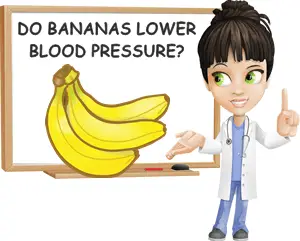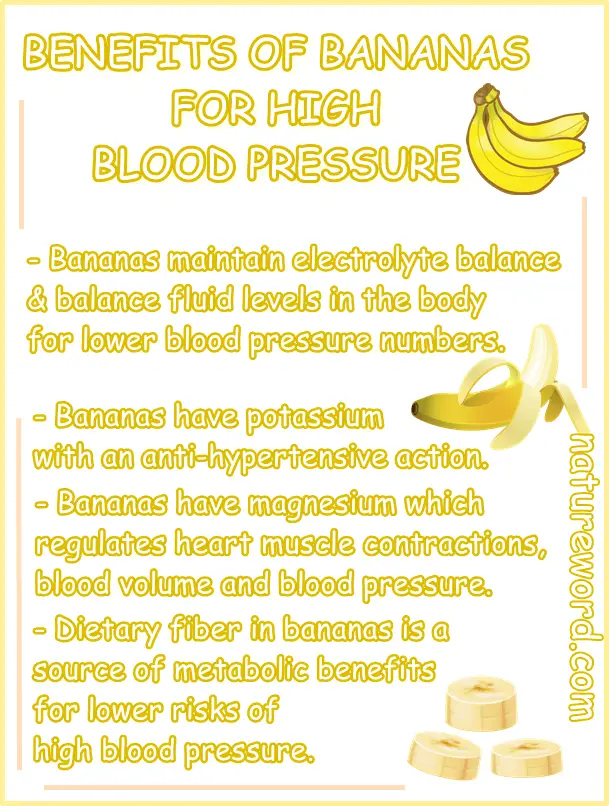Are bananas good for high blood pressure? If you have high blood pressure, can eating bananas help? To what extent? What exactly in bananas makes them good to eat for high blood pressure?
Can eating bananas treat high blood pressure? What foods are better than bananas for high blood pressure?
What is high blood pressure?
High blood pressure is formally called hypertension and consists of blood pressure numbers that are above a certain threshold. High blood pressure qualifies as heart disease, more specifically, arterial disease.
Two different parameters for blood pressure are measured, systolic and diastolic, and, together, account for what is commonly referred to as ‘blood pressure’.

Systolic blood pressure measures blood pressure when the heart is contracting, while diastolic blood pressure measures blood pressure when the heart is relaxing.
Naturally, systolic blood pressure is higher than diastolic because the heart is under more pressure when contracting.
Blood pressure starting at 140/90 mm Hg (millimeters mercury) and upwards is considered abnormally high and referred to as ‘high blood pressure’.
Do bananas lower high blood pressure numbers?
A diet rich in foods that are as close as possible to their natural state, that is, unprocessed or minimally processed, is vital for good cardiovascular health. Foods such as bananas have a specific nutritional makeup that is conducive to benefits for high blood pressure.
Regular consumption of the fruit is good for healthy blood pressure numbers.
However, it’s an important reminder that no food can cure a disease in the way medication does.
This being said, eating certain foods on a regular basis can serve to provide specific bioactive components that produce quantifiable beneficial effects for different aspects of health.

What are the benefits of bananas for blood pressure?
Bananas maintain electrolyte balance and balance fluid levels in the body for lower blood pressure numbers
Bananas have a good content of potassium, a dietary mineral and electrolyte with vital regulatory activities.
Potassium contributes to electrolyte balance, helping balance levels and effects of other electrolytes, such as sodium.
For example, while sodium raises pressure in blood vessels, potassium reduces pressure in blood vessels, essentially contributing to lower blood pressure numbers.
Just as important, by maintaining electrolyte balance, potassium offsets a major side effect of sodium: fluid retention.
Sodium causes the body to accumulate fluid and, as fluid builds up, pressure in blood vessels also rises.
By making sure you get enough potassium in the diet you can offset fluid retention brought on by a higher sodium intake, and enjoy lower blood pressure numbers.
Of course, efforts need to be be made in the direction of lowering sodium intake as well.
Bananas have potassium with an anti-hypertensive action
Potassium is vital for blood pressure control. Potassium has a direct action on vascular tone, relieving pressure in blood vessels which lowers blood pressure numbers.
How much potassium in a banana?
One very small banana at just 81 grams has 290 milligrams of potassium which is 6.1% of daily values for an adult person. One large banana at 136 grams has 487 milligrams of potassium which is a little over 10% of daily values for an adult person.
Find out more interesting facts about the potassium content of a banana, including how many bananas you need to eat to get all the potassium you need in a day.
Bananas have magnesium which regulates heart muscle contractions, blood volume and blood pressure
Bananas naturally have a good content of magnesium, providing 6.4% of all the magnesium an adult person needs in a day for every 100 grams of the fruit.
Magnesium is an essential nutrient and electrolyte needed to maintain electrolyte balance, regulate fluid levels in the body such as blood volume as well as muscle contractions, including contractions of the heart.
Not getting enough magnesium on a daily basis causes a range of side effects affecting the cardiovascular and muscular systems in particular.
Low magnesium affects the heart causing arrhythmias such as extrasystoles, but can also impact electrolyte balance and favor high blood pressure. Low magnesium also causes painful muscle contractions such as leg cramps, including calf cramps, foot cramps and leg cramps at night.
Dietary fiber in bananas is a source of metabolic benefits for lower risks of high blood pressure
High blood pressure is favored by excess fat tissue. Being overweight or obese causes metabolic changes that create a predisposition for heart disease, including arterial disease such as high blood pressure.
Excess weight leads to high cholesterol with plaque buildup, diabetes and arterial disease with hypertension.
Dietary fiber in bananas has cholesterol-lowering properties, helping both lower total cholesterol and LDL (bad) cholesterol levels, and improve cholesterol profile, favoring healthier HDL (good) cholesterol levels. Healthier cholesterol levels and profile means a lower risk of atherosclerosis and associated complications such as high blood pressure and cardiovascular events such as stroke and heart attack.
Not just this, but dietary fiber in bananas comes with prebiotic benefits, modulating gut flora populations in a way that favors weight control for lower risks of metabolic disease and associated forms of heart disease. Eating bananas provides metabolic benefits that favor weight management and reduce risks of diabetes, a major risk factor for high blood pressure.
Bananas exert a cardioprotective effect
Bananas are a source of bioactive antioxidants, anti-inflammatory components and other health-promoting constituents such as dietary fiber with metabolic benefits. Together, the biologically active constituents in the fruit contribute to exerting a cardioprotective effect that contributes to improving cardiovascular parameters such as blood pressure.
Is there something better for high blood pressure?
Bananas are not the only food to eat if you have high blood pressure. Many foods have anti-hypertensive benefits.
Some, like avocado or spinach, actively help lower blood pressure numbers thanks to their specific nutritional makeup e.g. high potassium content, high magnesium content and very low sodium.
In fact, both spinach and avocado are better sources of potassium and magnesium than bananas, and thus also technically better for high blood pressure.
However, you can’t eat just the two foods, so including bananas and other foods in your diet regularly is better overall for health, including blood pressure.
Others, like various herbs and preparations from less palatable foods, help lower high blood pressure numbers via specific bioactive constituents, mainly phenolics.
Hawthorn flowers, berries and leaves are used to make tea and supplements with impressive blood pressure lowering benefits.
See the benefits of hawthorn for blood pressure. Artichoke extract relies heavily on a concentrated amount of specific phenolics to lower blood pressure numbers.
See the benefits of artichoke extract for blood pressure.
